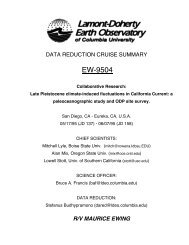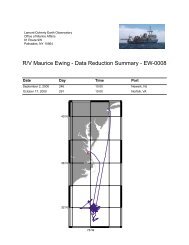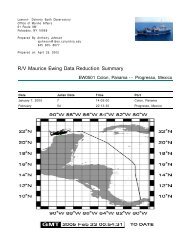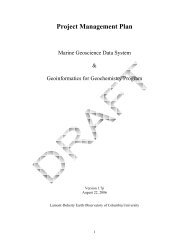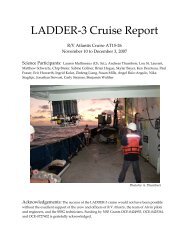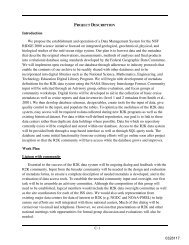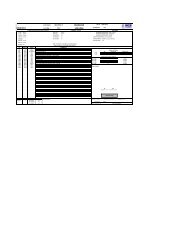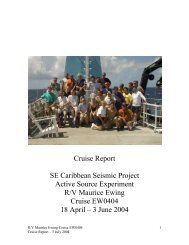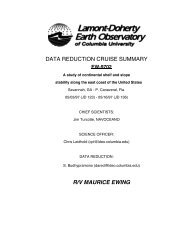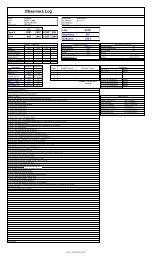NBP09-01 Cruise Report - British Oceanographic Data Centre
NBP09-01 Cruise Report - British Oceanographic Data Centre
NBP09-01 Cruise Report - British Oceanographic Data Centre
- No tags were found...
Create successful ePaper yourself
Turn your PDF publications into a flip-book with our unique Google optimized e-Paper software.
was under way (Figure 17). This method was refined over the next couple of recoveries, with the use of theAutosub recovery (Jack) float being abandoned in favour of a direct pick up by the small boat. It becamea practical, slick and more importantly safe method of recovery. The small boat was used in winds of upto 25kts with a wave height of about 0.6m (2 feet). The use of a small boat would limit the operationalwindow, but with the work site being within a bay and sea being damped by ice, sea conditions were nevera problem.3.5 Autosub missionsOutline plans for six science missions beneath the ice shelf, including three that penetrated 30 km into theouter cavity and three that penetrated the full 60 km to the grounding line, had been approved by NOCSprior to the cruise. Final planning of waypoints and profiles was guided by ice thickness data, from airborneradar sounding, the bulk of which was collected in early 2006, and seabed soundings from NBP0402, refinedwith multi-beam data collected during the course of <strong>NBP09</strong><strong>01</strong>. We also made extensive use of a Modisvisible image (Figure 18), collected in late December 2008. Where the ice is grounded, the combination ofice thickness and surface elevation from the radar observations gives the depth of the bed. We therefore hadknowledge of the seabed depth along the grounding line at the inner edge of the cavity. Depths there aresimilar to those at the ice front (800 to 1000 m) so we assumed that the bed would be fairly flat.Planned tracks and profiles for the six missions are shown in Figures 18 and 19. The three shorter missionswere intended to track the seabed at 200 m altitude on the way to the turning point, approximately 30km from the ice front, then ascend to track the ice base at 100 m clearance on the way out. A globalminimum depth of 500 m was set to prevent Autosub tracking up into hollows in the ice shelf base, while thezig-zag course on the way out was designed to sample a wider range of basal features with the multi-beamecho-sounder, which was oriented up for these missions. The original plan was then to run three furthermissions that extended these tracks by approximately 30 km into cavity. It was intended that the actualturning point would be determined by Autosub’s detection of minimum headroom, set at approximately200 m of water (i.e. about 100 m clearance above and below). For the inbound leg of the longer missionsAutosub would track the seabed at 100 m altitude, then track the ice base at 100 m clearance, so obtainingmulti-beam images of the ice base, as far as the 30 km point reached on the shorter missions. From thispoint out the sub would undulate between bounds set by minimum clearance of the ice base and seabed orglobal minimum and maximum depths, whichever were encountered first.The three shorter missions (M428-430) were successfully completed as above. Further discussions about thelonger missions led to the abandonment of the zig-zag course for the first part of the return leg, as far asthe point reached on the shorter missions. It was felt unwise to have multiple waypoints programmed forthe inner part of the cavity, where we were uncertain about the turning point. It was quite possible that thesub would detect minimum headroom at a point further out than one of these waypoints and then attemptfor a second time to go further into the cavity to reach its next waypoint. Finding the route blocked wouldthen trigger a mission abort.The first of the longer missions (M431) showed the dangers of tracking an irregular ice base without aminimum depth protection (the global minimum of 500 m, required for the outer part of the cavity, gave noprotection on the inner part), as the sub followed a course similar to the hypothetical one in Figure 16. Thetriggering of multiple collision avoidances (one of which was not actually avoided) led to the mission beingaborted, and a rethink for the final two missions. For these we planned only seabed tracking with an altitudeof 100 m in the inner cavity, and since we could not image the ice shelf base, switched the orientation ofthe multi-beam echo-sounder so that we could gather seabed imagery. The fifth mission (M433) was alsoaborted when minimum headroom was detected earlier in the mission than we had anticipated and the subturned to find its path to the next waypoint blocked by an ice keel. The sixth and final mission (M434)track was then further amended to access the inner cavity by a known safe route, then explore to the southand the north (Figure 17). Beyond the known safe area we planned only bottom tracking, although we ranat two altitudes (100 and 200 m) to the south, where we knew that the 500 m minimum depth would keep<strong>NBP09</strong>-<strong>01</strong> <strong>Cruise</strong> <strong>Report</strong> (p. 25 of 83) Revised February 27, 2009



